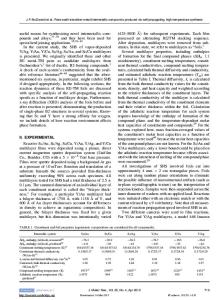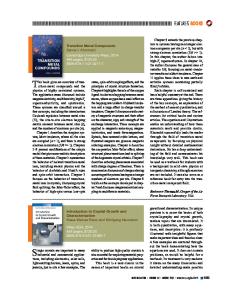Transition Metal and Rare Earth Compounds Excited States, Transition
There exists a large literature on the spectroscopic properties of copper(II) com- 9 pounds. This is due to the simplicity of the d electron configuration, the wide variety of stereochemistries that copper(II) compounds can adopt, and the f- xional geomet
- PDF / 3,014,519 Bytes
- 201 Pages / 439 x 666 pts Page_size
- 8 Downloads / 373 Views
Editorial Board: A. de Meijere • K.N. H o u k . H. Kessler ].-M. L e h n . S.V. L e y . S.L. S c h r e i b e r • ]. T h i e m B.M. Trost • F. V6gtle • H. Y a m a m o t o
Springer Berlin Heidelberg New York Barcelona Hong Kong London Milan Paris Singapore Tokyo
Transition Metal and Rare Earth Compounds Excited States, Transitions, Interactions II
VolumeEditor:HartmutYersin
With contributions by D. Donges, D. R. Gamelin, H. U. Giidel, M. J. Riley, H.Yersin
~
Springer
The series Topics in Current Chemistry presents critical reviews of the present and future trends in modern chemical research. The scope of coverage includes all areas of chemical science including the interfaces with related disciplines such as biology, medicine and materials science. The goal of each thematic volume is to give the nonspecialist reader, whether at the university or in industry, a comprehensive overview of an area where new insights are emerging that are of interest to a larger scientific audience. As a rule, contributions are specially commissioned. The editors and publishers will, however, always be pleased to receive suggestions and supplementary information. Papers are accepted for Topics in Current Chemistry in English. In references Topics in Current Chemistry is abbreviated Top. Curr. Chem. and is cited as a journal.
Springer WWW home page: http://www.springer.de Visit the TCC home page at http:llink.springer.delseriesltccl or http:/llink.springer-ny.comlseriesltccl
ISSN 0340-1022 ISBN 3-540-67976-6 Springer-Verlag Berlin Heidelberg New York Library of Congress Catalog Card Number 74-644622 This work is subject to copyright. All rights are reserved, whether the whole or part of the material is concerned, specifically the rights of translation, reprinting, reuse of illustrations, recitation,broadcasting, reproduction on microfilm or in any other ways, and storage in data banks. Duplication of this publication or parts thereof is only permitted under the provisions of the German Copyright Law of September 9, 1965, in its current version, and permission for use must always be obtained from SpringerVerlag. Violations are liable for prosecution under the German Copyright Law. Springer-Verlag Berlin Heidelberg New York a member of BertelsmannSpringer Science+Business Media GmbH © Springer-Verlag Berlin Heidelberg 2001 Printed in Germany The use of general descriptive names, registered names, trademarks, etc. in this publication does not imply, even in the absence of a specific statement, that such names are exempt from the relevant protective laws and regulations and therefore free for general use. Cover design: Friedhelm Steinen-Broo, Barcelona; MEDIO, Berlin Typesetting: Fotosatz-Service K6hler GmbH, 97084 Wiirzburg SPIN: 10719407
02/3020 ra - 5 4 3 2 1 0 - Printed on acid-free paper
Volume Editor Prof. Dr. Hartmut Yersin Institut ftir Physikalische und Theoretische Chemie Universit~it Regensburg Universit~itsstraf~e 31 93053 Regensburg, Germany E-maih [email protected]
Editorial Board Prof. Dr. A
Data Loading...










